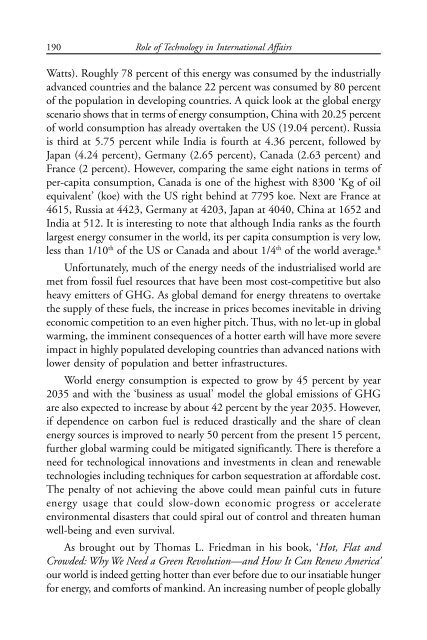ROLE OF TECHNOLOGY INTERNATIONAL AFFAIRS
book_role-of-technology-in-international-affairs_a-mallik_1
book_role-of-technology-in-international-affairs_a-mallik_1
You also want an ePaper? Increase the reach of your titles
YUMPU automatically turns print PDFs into web optimized ePapers that Google loves.
190<br />
Role of Technology in International Affairs<br />
Watts). Roughly 78 percent of this energy was consumed by the industrially<br />
advanced countries and the balance 22 percent was consumed by 80 percent<br />
of the population in developing countries. A quick look at the global energy<br />
scenario shows that in terms of energy consumption, China with 20.25 percent<br />
of world consumption has already overtaken the US (19.04 percent). Russia<br />
is third at 5.75 percent while India is fourth at 4.36 percent, followed by<br />
Japan (4.24 percent), Germany (2.65 percent), Canada (2.63 percent) and<br />
France (2 percent). However, comparing the same eight nations in terms of<br />
per-capita consumption, Canada is one of the highest with 8300 ‘Kg of oil<br />
equivalent’ (koe) with the US right behind at 7795 koe. Next are France at<br />
4615, Russia at 4423, Germany at 4203, Japan at 4040, China at 1652 and<br />
India at 512. It is interesting to note that although India ranks as the fourth<br />
largest energy consumer in the world, its per capita consumption is very low,<br />
less than 1/10 th of the US or Canada and about 1/4 th of the world average. 8<br />
Unfortunately, much of the energy needs of the industrialised world are<br />
met from fossil fuel resources that have been most cost-competitive but also<br />
heavy emitters of GHG. As global demand for energy threatens to overtake<br />
the supply of these fuels, the increase in prices becomes inevitable in driving<br />
economic competition to an even higher pitch. Thus, with no let-up in global<br />
warming, the imminent consequences of a hotter earth will have more severe<br />
impact in highly populated developing countries than advanced nations with<br />
lower density of population and better infrastructures.<br />
World energy consumption is expected to grow by 45 percent by year<br />
2035 and with the ‘business as usual’ model the global emissions of GHG<br />
are also expected to increase by about 42 percent by the year 2035. However,<br />
if dependence on carbon fuel is reduced drastically and the share of clean<br />
energy sources is improved to nearly 50 percent from the present 15 percent,<br />
further global warming could be mitigated significantly. There is therefore a<br />
need for technological innovations and investments in clean and renewable<br />
technologies including techniques for carbon sequestration at affordable cost.<br />
The penalty of not achieving the above could mean painful cuts in future<br />
energy usage that could slow-down economic progress or accelerate<br />
environmental disasters that could spiral out of control and threaten human<br />
well-being and even survival.<br />
As brought out by Thomas L. Friedman in his book, ‘Hot, Flat and<br />
Crowded: Why We Need a Green Revolution—and How It Can Renew America’<br />
our world is indeed getting hotter than ever before due to our insatiable hunger<br />
for energy, and comforts of mankind. An increasing number of people globally


